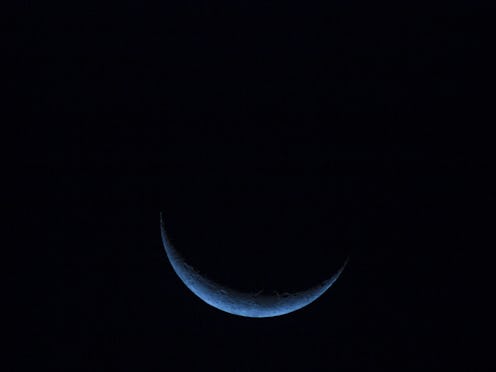Life
Here’s Why Everyone’s Talking About The “Dark Moon” Happening In February
Pretty much anytime something bad or just plain annoying happens, I blame it on a full moon... even when I'm not entirely sure that there's actually a full moon in the sky. Trouble sleeping? Full moon. Bickering with my husband? Full moon. Distracted at work? It's gotta be a full moon. If this sounds like you, you should know that there's no full moon to speak of in February 2018, which means that we're going to have to be a little more accountable for our bad days. What we will experience in February is a dark moon, though — a lunar phase that I'm personally just hearing about now. So what is a dark moon? You'll know it when you see it... or, more appropriately, when you don't see it.
A dark moon is pretty much exactly what it sounds like — a moon-shaped placeholder in the sky that looks, well, dark. It's basically the opposite of a super bright and shiny full moon. The new moon — during which the moon is completely dark with zero percent luminosity — occurs in the middle of a dark moon period, according to Moongiant. During this time, the moon appears dark (some would say invisible!) because it's set against the backdrop of the sun. A new moon technically only lasts for one day, while a dark moon period can extend for an extra day or two on either side of the new moon. According to the February 2018 lunar calendar, the next new moon will rise on Feb. 15, but the moon should look pretty dark on Feb. 14 and Feb. 16 too.
There's historical significance to the dark moon as well. Per Sciencing, astronomers in the days before high-powered telescopes and space travel would approximate the timing of the new moon according to the first appearance of a waxing crescent moon. Without the help of stronger telescopes and tools that could more accurately determine luminosity, it was much more difficult for them to put an exact date on the new moon each month. To avoid a similar ambiguity today, the scientific community now uses "dark moon" as a way to differentiate the longer period of apparent darkness from the single day of the lunar cycle when the moon is actually completely dark. We now have the technology to determine when the new moon is actually occurring, so the days around it need to be described differently! Hence, the dark moon.
Don't confuse the dark moon with the dark side of the moon — a classic Pink Floyd Album, a delicious chocolate cake, and an entirely separate astronomical term. According to Scienceing, the side of the moon that constantly faces away from the Earth is commonly described outside of the scientific community as "the dark side of the moon." This phrase is not, however, technically accurate. "In astronomical fact, the far side of the moon is not always dark. The side of the moon that faces away from Earth is only completely dark during the full moon; at all other times, it is partly lit and partly in shadow," per Sciencing.
A true dark moon, on the other hand, should leave little room for doubt. Without even checking the lunar calendar, you'll notice pretty easily in the middle of February that the man on the moon is basically impossible to make out during that period. Get your flashlights (or your phone flashlights, at least) ready if you're going to be doing any walking outside in a dimly lit area. Your reliable natural nightlight will be fully set against the backdrop of the sun... and of absolutely no help to you.
